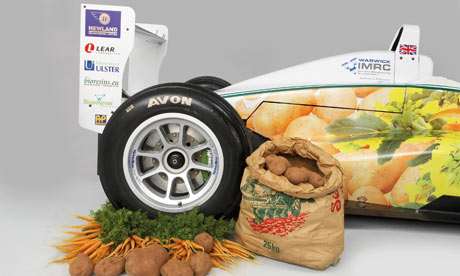British Science Festival 2009
Interview with
Diana - This year's British Science Festival has seen a bevy of scientists descend upon the University of Surrey to talk about their findings and experiments, some more unusual than others. And if anyone had trouble paying attention to all these talks, it seems the answer comes in the form of flavonoid-rich blueberries. Jeremy Spencer from the University of Reading has found that a dose of blueberries can help maintain your attention span for to up to five hours.
Jeremy - We took a group of younger individuals and older individuals and we brought them to the University of Reading and we gave them a controlled breakfast then we performed the series of cognitive tasks, which measured things like short-term memory, attention and motor performance, and then we gave them a blueberry smoothie, if you like, 200 grams of blueberry ground up. One hour after that, they performed a cognitive task again and then again after five hours. What we found was, over the five-hour period we had deterioration on the control group. Their attention was found to drop over the five-hour period whereas for the ones who were taking the blueberry attention remained high. In other intervention studies, it certainly seems that blood flow to the brain is involved in these processes.
Diana - They think that flavonoid-rich foods serve to dilate the blood vessels and increase blood flow to the brain thereby improving attention spans. Jeremy Spencer, University of Reading. Something most of us will pay attention to is a good-looking person. But what is it that makes one person more attractive  than another? A number of studies have looked at symmetry and youthfulness but Tony Little at the University of Stirling thinks it also has something to do with the company you keep.
than another? A number of studies have looked at symmetry and youthfulness but Tony Little at the University of Stirling thinks it also has something to do with the company you keep.
Tony - We've also been studying copying-like effects whereby people are kind of taking information from other people's mate choice decisions and from that, we found that if you pair someone with an attractive partner then that increases their attractiveness and if you pair them with an unattractive partner, that decreases their attractiveness. So yes, I think when you see Hugh Heffner, he might not be the most attractive man but if you see him with his Playboy beauties then perhaps you can infer that there's something good about him like having money or perhaps he's personally very nice and pleasant.
Diana - Hugh Heffner: possibly pleasant. Tony Little from the University of Stirling. Also at the festival this year, were some attractive developments in technology. One such modification to everyday objects created an intelligent home for Andy Stamford-Clark.
 Andy - So, I've got my house linked up to various sensors to monitor things that are happening like whether the windows are open, how much power are we are using, how many litres of water we've used during the day and things like that. But when I discovered Twitter a couple of years ago, I thought it would be quite cool to link objects to Twitter so Tweetjects objects that Twitter. And so, I built a gateway from the messaging system through to Twitter which means that anything that's used in my house basically, can now make up a Twitter message and send it out to the Twitterverse, which talks about things like five pounds' worth of electricity used so far this month or 100 litres of water used so far today or the phone's ringing. So, the main thing has been the power saving. I've reduced my electricity bill by about a third in the year since I've been using it, which is several hundred pounds back in my pocket, which is very nice. It saved us once from wasting a lot of water. I got three texts in a row on my phone from Twitter saying 100 litres used, 200 litres used, 300 litres used and I quickly stopped the car and phoned my wife and said, "What's happening?" Have we got a flood. And she looked out the window and saw the nozzle had flown off the end of the hose pipe, and it was just pumping water into the garden so that saved us wasting a whole lot of water which, as we're on the Isle of Wight, we're metered so that would've cost us money and of course it's a valuable resource so that was a good thing.
Andy - So, I've got my house linked up to various sensors to monitor things that are happening like whether the windows are open, how much power are we are using, how many litres of water we've used during the day and things like that. But when I discovered Twitter a couple of years ago, I thought it would be quite cool to link objects to Twitter so Tweetjects objects that Twitter. And so, I built a gateway from the messaging system through to Twitter which means that anything that's used in my house basically, can now make up a Twitter message and send it out to the Twitterverse, which talks about things like five pounds' worth of electricity used so far this month or 100 litres of water used so far today or the phone's ringing. So, the main thing has been the power saving. I've reduced my electricity bill by about a third in the year since I've been using it, which is several hundred pounds back in my pocket, which is very nice. It saved us once from wasting a lot of water. I got three texts in a row on my phone from Twitter saying 100 litres used, 200 litres used, 300 litres used and I quickly stopped the car and phoned my wife and said, "What's happening?" Have we got a flood. And she looked out the window and saw the nozzle had flown off the end of the hose pipe, and it was just pumping water into the garden so that saved us wasting a whole lot of water which, as we're on the Isle of Wight, we're metered so that would've cost us money and of course it's a valuable resource so that was a good thing.
Diana - A home that Twitters, Andy Stanford-Clark from IBM, UK. Another creation with environmental considerations was the "Worldf3rst" part-recycled Formula 3 car. Formula racers tend to conjure up images of enormous budgets, exploding champagne bottles and general indulgence but Kerry Kirwan from the University of Warwick is taking a slightly different approach with his car made out of, among other things, beetroot and carrots.
 Kerry - Well, the "Worldf3rst" Formula 3 car has a whole raft of environmentally friendly technologies on it so it's made from recycled materials or waste materials and then some natural materials. It has a carrot-fibre steering wheel. It runs on bio-diesels brewed from waste chocolate and waste alcohol, and it's got natural fibre composite panels on it. It's got recycled carbon fibre panels on. It's lubricated by vegetable oils and it also has a catalyst that converts low-level ozone to oxygen as you're driving along so it helps to cancel out smog and things.
Kerry - Well, the "Worldf3rst" Formula 3 car has a whole raft of environmentally friendly technologies on it so it's made from recycled materials or waste materials and then some natural materials. It has a carrot-fibre steering wheel. It runs on bio-diesels brewed from waste chocolate and waste alcohol, and it's got natural fibre composite panels on it. It's got recycled carbon fibre panels on. It's lubricated by vegetable oils and it also has a catalyst that converts low-level ozone to oxygen as you're driving along so it helps to cancel out smog and things.
Diana - And when's the next outing? Can we see her in action anytime soon?
Kerry - We hope she's going to be running for her first competitive race in October at Brands Hatch and she's already done the Goodwood Festival of Speed and done the hill climb there a half dozen times and was very fast and a great crowd pleaser so it has given us comfort that she could do well in a Formula 3 race.
Diana - I think that counts as one of your five-a-day. Kerry Kirwan from the University of Warwick. Now, even Kerry's car will pump out some carbon dioxide during manufacture and the race itself but there are ways of recapturing carbon after it has been emitted. One method involves pumping carbon dioxide into underground cave systems and porous rocks. And Stuart Haszeldine from the University of Edinburgh has found that the UK is particularly well-placed to do this.
Stuart - So it looks like 95% of the storage available is in saltwater aquafers, the other 5% is in depleted oil fields and in depleted gas fields. That storage could take several hundred years of UK emissions from power stations and what we're promoting is that could actually take 100 years of power station emissions from all of Northwest Europe instead of putting the next hundred years of carbon dioxide into the atmosphere from Germany and Denmark and Belgium and Holland and Poland. Instead, we could build a large set of pipelines and inject that deep beneath the North Sea and the UK could charge a rent for that and make money out of that.
Diana - Carbon storage for sale and that was Stuart Haszeldine from the University of Edinburgh. And although storage capacity is finite, it might give us a bit more time to get around to replacing our bulbs or decide what we want to do about bio-fuels or nuclear power or wind farms or hydrogen fuel cells and oh, everything else.
- Previous Mending a Broken Heart
- Next Nanobots to the Rescue









Comments
Add a comment